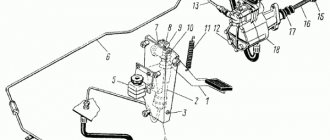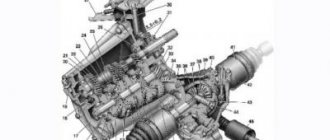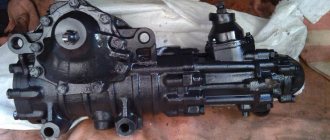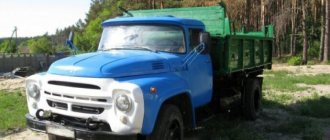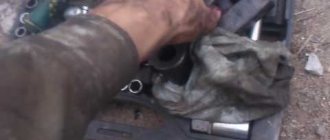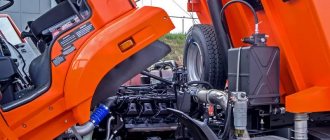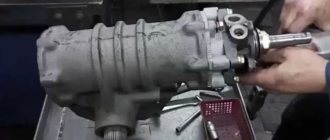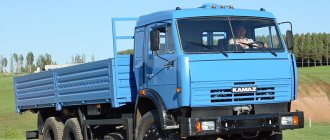KAMAZ device for beginners
KamAZ vehicles consist of a large number of complex units, assembly units and parts.
Onboard tractor-trailer has more than 1,400 assembly units consisting of 5,000 parts. The KamAZ-740 power unit has about 300 assembly units consisting of 1,400 parts. Many vehicle assembly units are made one-piece. The KamAZ vehicle contains about 760 welded joints. Arc welding produces more than 10 m of welded seams, and seam welding - 8 m. In the cabin, sides and other assembly units, parts are secured with 8000 welding points. The design of the car includes a chassis, an engine, a cabin, a platform with metal sides and a base. The design of the KamAE-5320 tractor-trailer is shown in Fig. 2.
The source of mechanical energy is the engine that drives the car.
Promotional offers based on your interests:
The chassis consists of the following main parts: – a power transmission necessary to transmit torque from the engine to the driving wheels of the vehicle; – the chassis, which serves to attach all units and mechanisms to the frame and ensure the movement of the vehicle; – control mechanisms that provide control of the vehicle’s movement, braking and stopping.
The power transmission of a car includes the following units and mechanisms: clutch, gearbox, cardan drive, final drives, differentials, axle shafts.
The clutch is designed to connect the engine with the transmission when starting the car and transmitting torque when it moves, disconnecting the engine from the transmission when changing gears and stopping for a short time.
The gearbox provides a change in torque on the drive wheels, a change in the speed of the vehicle, reverse the vehicle and disconnects the transmission from the engine when parked while the engine is running.
The cardan transmission serves to transmit force from the gearbox to the main gear at variable shaft inclination angles.
The main gear is designed to increase traction on the drive wheels of the vehicle and transmit forces from the drive shaft to the axle shaft at an angle of 90°. A differential with axle shafts allows the drive wheels to rotate at different speeds when the car turns.
The main gear and differential with axle shafts, enclosed in a casing made of malleable cast iron, are called the drive axle.
Drive axles, which transmit torque from the driveshaft to the drive wheels, are part of the vehicle's bogie.
The power transmission of all-terrain vehicles has a drive and steering axle instead of a front axle, as well as a transfer case and two cardan shafts that transmit torque from the gearbox to the transfer case and from it to the front axle.
The chassis of a car consists of a frame, wheels, front axle (axle), rear axle (axles) and suspension, which includes springs and shock absorbers. The front and rear axles with wheels connected to the frame form the vehicle's bogie. A car bogie can have two, three or more than three axles.
Rice. 2. General structure of the car: 1 - engine; 2 – clutch; 3 - gearbox
Vehicles with two axles, driven by an engine to the rear wheels and steered by the front wheels, are called off-road vehicles. Such cars are designated with a 4X2 wheel arrangement. The first number indicates the number of wheels on the axles, and the second number indicates the number of driving wheels. In this case, twin tires on axles are considered one wheel.
Cars with two drive axles (front and rear), i.e. with all drive wheels, are designated by the 4X4 wheel arrangement.
Vehicles with three axles, having two rear driving axles, i.e. with all driving wheels on the rear bogie, and only the front axle being steered, are called off-road vehicles and are designated by the 6X4 wheel arrangement.
Vehicles with three drive axles are called all-terrain vehicles and are designated by the 6X6 wheel arrangement.
The control mechanism consists of a steering and braking system. The steering is connected to the front wheels and serves to change the direction of movement of the car. It is equipped for easy control of hydraulic boosters. The braking system reduces the speed of movement, quickly stops the car and brakes it in place.
Flatbed vehicles and dump trucks have a separate cabin for the driver and two passengers, as well as a platform for stowing cargo. On truck tractors, instead of a platform, a fifth wheel device is installed, designed for towing a semi-trailer.
History of creation
After L.N. came to power. Brezhnev, a wave of economic development began in the country. Accordingly, the volume of cargo transportation has increased. The question arose about increasing the body on trucks, which could be achieved through a cabover cab design.
It is worth noting that there were no serial cabovers in the Soviet automotive industry at that time. The MAZ-500 had been in development for several years and the start date for production was unknown.
Once again, domestic developers had to pay attention to the Western fleet of trucks.
For the sample, several production models of the cabover type were purchased in the USA.
The chief designer of the ZIL automobile enterprise, Anatoly Mavrikievich Krieger, chose the American “International” truck of the 220 series. Soviet engineers decided to take the project to a higher level thanks to innovative solutions, including:
- driver comfort;
- increased visibility;
- easy controls;
- economical fuel consumption;
- reliable transmission.
In 1967, the KEO automobile plant team began developing a prototype model, which would later be assigned the ZIL-170 index. As a basis, we took the design of the ZIL-133 diesel chassis, the serial production of which was postponed.
The terms of reference envisaged the production of ten cargo modifications of highway vehicles with a 4X2/6X4 wheel arrangement for operation in a group of road trains with a permissible maximum weight of up to 26,500 kg. It was also necessary to create six 6X6 vehicles with permanent drive for the needs of the army and difficult terrain.
A prototype of a promising truck was created in 1968. The prototype was equipped with a diesel engine from a Yaroslavl plant (YaMZ). The ZIL-170's baptism of fire took place on the highway from Uglich to Rybinsk in May 1969. The vehicle was also tested on the serpentine roads of the Caucasus Mountains, where the transmission took on maximum loads.
The sudden resolution of the Central Committee of the USSR Party on the construction of factories for the production of trucks in the Tatar Autonomous Soviet Socialist Republic, Naberezhnye Chelny, upset Moscow automakers.
The ZiL team spent several years perfecting the car and did not want to part with their brainchild. But the party’s order was not disputed and further work with the prototype was transferred to new workshops of the Tatar Republic.
According to the state plan, the built automobile plant was supposed to annually produce 150,000 units of equipment and 250,000 engines. The name of the truck was changed to KamAZ. The first prototype of the Kama plant equipment was released in 1974.
Serial models delighted Soviet society with their birth on February 16, 1976. This happened on the eve of the 25th Congress of the CPSU, which opened on February 24. The cabs of the new KamAZ trucks were decorated with workers’ slogans “Our gift to the XXV Congress of the CPSU.”
According to the production plan, from 1976 to 1978, the company produced only three modifications of the serial KamAZ-5320:
- onboard platform with a lifting capacity of 8 tons;
- construction dump truck 10 t;
- truck tractor with a permissible weight of 26.5 tons.
Among the total volume of equipment produced, 43% were dump trucks, followed by on-board platforms 27% and the remaining 20% related to the production of truck tractors with a new ten-speed gearbox.
In 1981, KamAZ launched the second stage of production facilities, which began producing the 6-ton 4310 vehicle with a 6X6 wheel arrangement and single-pitch tires.
The military version of the 4310 was equipped with a winch, a pneumatic tire pressure control system and two fuel tanks. The agricultural version 43105 was simplified and weighed 7 tons.
Only by the mid-80s did the car plant in Naberezhnye Chelny enter a stable production cycle. The high pace allowed the millionth truck to be produced by October 1988. The expected demand for a domestic truck from international customers did not materialize. This situation allowed KamAZ to take a strong position only in the domestic market.
Another sad moment for the truck was the period of perestroika. Imported trucks began to arrive in the USSR, which were crowding out the car in their own country. KamAZ could not compete with them, which forced the plant to begin developing a new generation of vehicles, the production of which began in the 90s.
How to properly drive a KamAZ. Cool Comics of 1983
How to quickly explain the basic principles of control and maintenance of a complex mechanism even to amateurs? Even during the Second World War, it turned out that comics and various graphic materials significantly speed up the process of learning and memorizing material. In 1983, the Kama Automobile Plant also decided to release its own comics, which were called “Practical advice for the driver of a KamAZ car.”
Several similar instructions were made at the factory, which are kept in the museum. One of the options was recently published by Kamaz-Online. Let's see how KamAZ trained future drivers.
“You start working on a KamAZ vehicle. This is a car of a modern design, which has many innovations that you may not have encountered before,” this is how the story in the book begins.
Such brochures were supposed to reduce the number of malfunctions that occurred during the operation of trucks due to insufficient qualifications of drivers. One of the pages showed in clear language how and why to adjust the seat stiffness. There is even a comparative image of thin and fat drivers. One reduces the hardness, the other increases it.
The next slide covers a rather complicated starting procedure with a thermostat. The instructions consist of 7 points, and you definitely had to do it several times before you could remember it. At the same time, it was indicated that a serviceable engine with well-charged batteries starts reliably at temperatures down to -15 degrees.
Continuation of the previous slide. Here is an explanation of the even more complex process of starting with a heater. This method is recommended to be used at ambient temperatures below 15 degrees Celsius. Are there KamAZ drivers among us? Check yourself whether you are starting with the heater correctly!
The operating manuals of almost all modern cars recommend that you do not warm up the engine at idle speed, because this is harmful to the environment and the engine itself. But KamAZ won’t write garbage, right? It clearly says: “Warm up the engine before driving.” And it's a damn good decision, I tell you. During warm-up, the driver must prepare the truck for the road.
The instructions contain not only the correct procedure for performing a particular procedure, but also common driver mistakes. For example, you should not give a cold engine too high a speed and a heavy load.
The next slide talks about the color-coded zones on a truck's tachometer. In the black zone the engine pulls poorly and runs jerkily, the green zone is the working zone where the engine develops maximum power, and the arrow should not enter the red fields.
For those who have forgotten how to use a gearbox with a divider, there is a detailed hint. I won’t quote you, read it yourself if this is relevant to you, or you just always wanted to know how a gearbox with a divider works. The description is based on the example of a 10-speed gearbox with 2 reverse gears.
Engine
The KamAZ-5320 engine is a 4-stroke diesel unit of the KamAZ-740.10 model with an 8-cylinder design. The engine has a V-shaped cylinder arrangement and closed-type nozzles. The power plant includes an all-mode speed controller, a dry air filter with a clogging indicator and a replaceable filter element, a fuel injection advance clutch and an electric flare device (EFD). Optionally, the unit is equipped with a pre-start heater PZD-30.
Characteristics of the KamAZ-740.10 engine:
- working volume – 10.85 l;
- rated power – 154 (210) kW (hp);
- maximum torque – 637 Nm;
- rotation speed – 2600 rpm.
- cylinder diameter – 120 mm.
Basic basic models of KamAZ vehicles
Warranty periods for Kamaz vehicles, running-in period and frequency of maintenance
The accumulated experience in operating vehicles and the constant improvement of their design by the Kama Association for the Production of Heavy-Duty Vehicles allows us to draw fairly objective conclusions about the high reliability of KamAZ vehicles. The reliable operation of machines and their components, including all products manufactured by other factories, except tires and batteries, is guaranteed by the Kama Association. Warranty periods are calculated:
- upon receipt of the car directly from the manufacturer - from the moment the car is handed over to the consumer;
- when delivering cars to the consumer by rail or water transport - from the date of shipment from the factory, not counting the time spent en route to the destination.
During the warranty period, the manufacturer replaces free of charge all parts, components and assemblies that prematurely failed due to the fault of the plant. Warranties for tires and batteries are given by the manufacturers of these products in accordance with the standards or technical conditions approved for them. When operating vehicles in violation of the factory instructions and making any design changes to them without agreement with the manufacturer (Kama Association), the latter will not accept or consider complaints. KamAZ vehicles have a longer break-in period compared to other car brands. The operational run-in period is 4000 km. The following frequency of maintenance has been established: TO-1000 is carried out every 500-1000 km; TO-1 - after 2400-4000 km; TO-2 - after 7200-12000 km. Seasonal maintenance (SM) is performed 2 times a year - in spring and autumn. Estimated maintenance frequency is 24,000 km. Compliance with the requirements for operating vehicles during the break-in period and timely performance of technical maintenance ensure that KamAZ-5320 vehicles and its modifications travel more than 300 thousand km without major repairs. The warranty period and types of technical maintenance of KamAZ vehicles performed during the period from the start of operation to major repairs are shown in Fig. 4. The number of technical services performed during the overhaul period of operation (300 thousand km) is as follows: TO-1000 - 1; TO-4000 - 1; TO-1 - 50; TO-2 - 24.
Rice. 4. Warranty period, types of technical maintenance of KamAZ vehicles in the period from the start of operation to major repairs: TO-1000 - maintenance carried out during the initial period of operation of the vehicle 500-1000 km;
TO-4000 - maintenance carried out at the end of the vehicle's running-in period after 3000-4000 km; TO-1 - maintenance carried out during the main period of vehicle operation after 2400-4000 km; TO-2 - maintenance carried out during the main period of vehicle operation after 7200-12000 km; major repairs - after the vehicle has run for 300,000 km General information about the design of the Kamaz vehicle
Structurally, the car can be divided into main parts: engine, chassis, cabin and platform. The diagram of the car is shown in Fig. 1. The engine is the source of mechanical energy that drives the car. The chassis consists of several components designed to mount all units and mechanisms, transmit torque from the engine to the drive wheels, provide movement, control and braking. The main parts of the chassis include:
- power transmission necessary to transmit torque from the engine to the driving wheels of the car;
- chassis, which serves to attach all units and mechanisms to the frame and ensure vehicle movement;
- control mechanisms that provide control of vehicle movement, braking and stopping.
Rice. 1. Diagram of the general structure of the Kamaz vehicle:
1 - engine; 2 — clutch; 3 — gearbox; 4 — cardan transmission; 5 - middle bridge; 6 - frame; 7 — rear suspension;
The power transmission of a car includes the following units and mechanisms: clutch, gearbox, cardan drive, final drive, differential and axle shafts. The clutch is designed to connect the engine to the transmission when the car starts from a standstill and transmit torque when it moves, disconnect the engine from the transmission when changing gears and stopping for a short time. The gearbox provides a change in torque on the drive wheels, a change in the speed of the vehicle, reverse the vehicle and disconnects the transmission from the engine when parked while the engine is running. The cardan transmission serves to transmit force from the gearbox to the main gear at variable shaft inclination angles. The main gear is designed to increase traction on the drive wheels of the vehicle and transmit forces from the drive shaft to the axle shaft at an angle of 90°. A differential with axle shafts allows the drive wheels to rotate at different speeds when the car turns. The main gear and differential with axle shafts, enclosed in a casing made of malleable cast iron, are called the drive axle. Drive axles, which transmit torque from the driveshaft to the drive wheels, are part of the vehicle's bogie. The power transmission of all-terrain vehicles has a drive and steering axle instead of a front axle, as well as a transfer case and two cardan shafts that transmit torque from the gearbox to the transfer case and from it to the front axle. The chassis of a car consists of a frame, wheels, front axle (axle), rear axle (axles) and suspension, which includes springs and shock absorbers. The front and rear axles with wheels connected to the frame form the vehicle's bogie. A car bogie can have two, three or more than three axles. Vehicles with two axles, driven by an engine to the rear wheels and steered by the front wheels, are called off-road vehicles. Such vehicles are designated with a 4X2 wheel arrangement. The first number indicates the number of wheels on the axles, and the second number indicates the number of driving wheels. In this case, twin tires on axles are considered one wheel. Cars with two drive axles (front and rear), i.e. with all drive wheels, are designated by the 4X4 wheel arrangement. Vehicles with three axles, having two rear driving axles, i.e. with all driving wheels on the rear bogie, and only the front axle being steered, are called off-road vehicles and are designated by the 6X4 wheel arrangement. Vehicles with three drive axles are called all-terrain vehicles and are designated by the 6X6 wheel arrangement. The control mechanism consists of a steering and braking system. The steering is connected to the front wheels and serves to change the direction of movement of the car. It is equipped for easy control of hydraulic boosters. The braking system reduces the speed of movement, quickly stops the car and brakes it in place. Flatbed vehicles and dump trucks have a separate cabin for the driver and two passengers, as well as a platform for stowing cargo. On truck tractors, instead of a platform, a fifth wheel device is installed, designed for towing a semi-trailer.
Instructions
Now we suggest you find out how to start and in what sequence to correctly engage the gears on a KAMAZ gearbox. There are certain features in this process, and the procedure for changing gears differs from passenger cars.
Start of movement
You need to know how to change gears on a KamAZ. The start of movement on KamAZ should be done at a reduced speed
Please note that when driving away, the gear shift is carried out with the clutch disengaged. In KAMAZ gearboxes, the switching scheme is carried out in several stages, this is due to the peculiarities of increasing and decreasing speeds
How to turn on the speeds on KamAZ:
- The truck can drive quickly on different types of roads, but at the first stage, in accordance with the diagram, it is recommended to start driving in gear 1B.
- After this, 2V transmission is switched on.
- At the final stage of starting from a standstill, speed 3B is switched on.
In accordance with this traffic pattern, the vehicle starts at a reduced speed. That is, the shift lever on the box does not need to be touched until fourth gear. To start moving, you need to increase the crankshaft speed to about seven thousand revolutions (the author of the video lesson on how to switch gears on a KamAZ truck is Nikita Vagin).
Switching speeds
Now we’ll tell you how the gearbox on a KamAZ is switched when the car starts moving. When the car accelerates, the gear shift order on KamAZ is as follows - 4N-4V-5N. To activate the second speed, the crankshaft speed must increase to three thousand revolutions according to the tachometer. Please note that the operation of the crankshaft plays a major role. By changing gears correctly, you can achieve savings in fuel consumption. In this case, the most economical operation of the motor without downtime will be achieved.
Reverse
As for reverse, according to the diagram, to activate it, you need to set the switch to the lower left position. Activating reverse gear is not allowed while driving. To engage reverse, stop the vehicle completely and then perform the maneuver.
